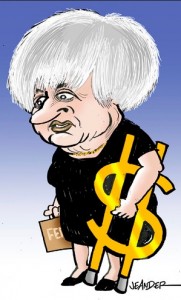Could have been said about the Gilded Age and the 1920s, when similar questions were raised and, incidentally, gave rise to a formulation called the “Great Gatsby curve,” the relationship between income inequality and low social mobility that recent economists came up with.
Only this time, it’s more so. “The past several decades have seen the most sustained rise in inequality since the 19th century after more than 40 years of narrowing inequality following the Great Depression,” Yellen said, citing the Federal Reserve’s triennial Survey of Consumer Finances, published last month, and other data.
“By some estimates, income and wealth inequality are near their highest levels in the past hundred years, much higher than the average during that time span and probably higher than for much of American history before then.”
Yellen is not the first to point this out, but the fact that it’s being made by the world’s most powerful central banker, and in such stark language, may hopefully give it some added purchase. “Stagnant or falling living standards for many families” went side-by-side with the wealthiest 5 percent’s share of total wealth reaching 63 percent in 2013, up from 54 percent in 1989.
“To put that in perspective, the average net worth of the lower half of the distribution, representing 62 million households, was $11,000 in 2013. About one-fourth of these families reported zero wealth or negative net worth, This $11,000 average is 50 percent lower than the average wealth of the lower half of families in 1989, adjusted for inflation.”
“Meanwhile, the average real wealth of families in the top 5 percent has nearly doubled, on net — from $3.6 million in 1989 to $6.8 million in 2013.”
And, a brief example of the Great Gatsby curve: “Other research tells us that inequality tends to persist from one generation to the next. … Research also indicates that economic mobility in the United States has not changed much in the last several decades; that mobility is lower in the United States than in most other advanced countries.”
So much for rags-to-riches. What can be done? While some inequality will always be with us, says Yellen, she offers offers “four building blocks of opportunity” to help level the playing field
The first two “cornerstones” focus on improving education and other resources for “children in their most formative years,” and easing the unequal debt burden a college education imposes on the less well-off. Generally speaking this will require more government spending, a stronger social safety net, and reforming how public education is paid for. Hint: Maybe it’s not through property taxes.
Building block No. 3: Start a business. “A significant source of wealth,” notes Yellen, but much harder to get, especially for those in the lower income categories, where business ownership “has fallen to a 25-year low, and equity in those businesses, adjusted for inflation, is at its lowest point since the mid-1990s.”
The editors of W-T-W.org Women and Finance are recommending a 20 year infrastructure repair and building program in the US which would take care of badly needed improvements and also employ people while we figure out how to match job readiness with available jobs.











